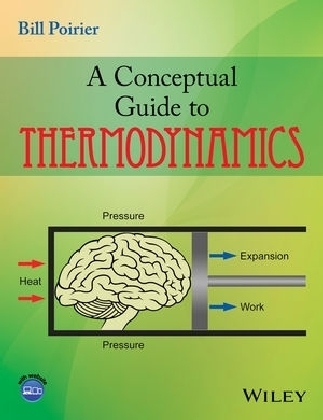
A Conceptual Guide to Thermodynamics
John Wiley & Sons Inc (Verlag)
978-1-118-84053-5 (ISBN)
A Conceptual Guide to Thermodynamics serves as a concise, conceptual and practical supplement to the major thermodynamics textbooks used in various fields. Presenting clear explanations of the core concepts, the book aims to improve fundamental understanding of the material, as well as homework and exam performance.
Distinctive features include:
Terminology and Notation Key: A universal translator that addresses the myriad of conventions, terminologies, and notations found across the major thermodynamics texts.
Content Maps: Specific references to each major thermodynamic text by section and page number for each new concept that is introduced.
Helpful Hints and Don’t Try Its: Numerous useful tips for solving problems, as well as warnings of common student pitfalls.
Unique Explanations: Conceptually clear, mathematically fairly simple, yet also sufficiently precise and rigorous.
A more extensive set of reference materials, including older and newer editions of the major textbooks, as well as a number of less commonly used titles, is available online at http://www.conceptualthermo.com.
Undergraduate and graduate students of chemistry, physics, engineering, geosciences and biological sciences will benefit from this book, as will students preparing for graduate school entrance exams and MCATs.
Professor Bill Poirier, Department of Chemistry & Biochemistry, Texas Tech University, USA Professor Poirier is Professor of Chemistry and Biochemistry and Joint Professor of Physics at Texas Tech University, where he has held research positions since 2001. His research is concerned with the development and application of new methods for performing accurate quantum dynamics calculations with unprecedented computational efficiency, to allow calculations for larger systems than ever before. This has wide ranging applications in areas including astrophysics, environmental, atmospheric and combustion chemistry, materials, and hydrogen storage. Professor Poirier has extensive teaching experience at undergraduate and graduate level, teaching undergraduate courses in general chemistry and physical chemistry, and graduate courses in chemical kinetics, molecular spectroscopy and statistical mechanics.
Preface xi
Acknowledgments xiii
Textbook Guide xv
0.1 List of Thermodynamics Textbooks by Discipline xv
0.2 Terminology and Notation Used in This Book xvi
0.3 Terminology and Notation Used in Textbooks xviii
1 About This Book 1
1.1 Who Should Use This Book? 2
1.2 Philosophy of This Book 3
1.3 Four Core Concepts of Thermodynamics 3
1.4 How to Use This Book 5
I Equilibrium
2 Philosophy of Thermodynamics 11
2.1 Thermodynamics 11
2.2 Scientific Models & Laws 12
2.3 Statistical Mechanics 14
3 Thermodynamic States, Variables & Quantities 17
3.1 Thermodynamic Variables & Quantities 17
3.2 More on Thermodynamic Quantities 19
3.3 Thermodynamic & Molecular States 20
4 Zeroth Law & Thermodynamic Equilibrium 23
4.1 Equation of State 23
4.2 Thermodynamic Equilibrium 26
4.3 Zeroth Law 27
4.4 Ideal Gases & Non-ideal Systems 29
II Energy
5 Molecular Energy, Internal Energy, & Temperature 33
5.1 Energy at the Molecular Scale 33
5.2 Internal Energy 35
5.3 Intermolecular Interactions & the Kinetic Model 37
5.4 Equipartition Theorem & Temperature 38
6 Boltzmann Distribution & the Kinetic Model 41
6.1 Boltzmann Distribution 41
6.2 Maxwell-Boltzmann Distribution 42
6.3 Maxwell Distribution of Speeds 44
III Thermodynamic Change
7 First Law & Thermodynamic Change 49
7.1 System & Surroundings 49
7.2 Thermodynamic Change 50
7.3 First Law 52
8 Work, Heat, & Reversible Change 55
8.1 State Functions & Path Functions 55
8.2 Definition of Work 57
8.3 Definition of Heat 59
8.4 Reversible & Irreversible Change 60
8.5 A Gas Expansion Example 62
9 Partial Derivative Quantities 65
9.1 Internal Energy & Heat Capacity at Constant Volume 66
9.2 Enthalpy & Heat Capacity at Constant Pressure 67
9.3 Other Partial Derivative Quantities 70
9.4 Partial Derivatives & Differentials 71
IV Entropy
10 Entropy & Information Theory 77
10.1 Why Does Entropy Seem So Complicated? 77
10.2 Entropy as Unknown Molecular Information 79
10.3 Amount of Information 80
10.4 Application to Thermodynamics 84
11 Entropy & Ideal Gas 87
11.1 Measuring Our Molecular Ignorance 87
11.2 Volume Contribution to Entropy 88
11.3 Temperature Contribution to Entropy 91
11.4 Combined Entropy Expression 92
11.5 Entropy, Heat, & Reversible Adiabatic Expansion 94
12 Second Law & Spontaneous Irreversible Change 97
12.1 Heat Engines & Thermodynamic Cycles 97
12.2 Traditional Statements of the Second Law 98
12.3 Entropy Statement of the Second Law 99
12.4 Information Statement of the Second Law 100
12.5 Maximum Entropy & the Clausius Inequality 103
13 Third Law, Carnot Cycle, & Absolute Entropy 107
13.1 Entropy & Reversible Change 107
13.2 Carnot Cycle & Absolute Zero Temperature 109
13.3 Third Law & Absolute Entropy 111
V Free Energy
14 Free Energy & Exergy 115
14.1 What Would Happen If Entropy Were a Variable? 116
14.2 Helmholtz and Gibbs Free Energies 117
14.3 Second Law & Maximum Work 119
14.4 Exergy 121
15 Chemical Potential, Fugacity, & Open Systems 123
15.1 What Would Happen If n Were a Variable? 123
15.2 Chemical Potential 125
15.3 Ideal Gas & Fugacity 126
VI Applications
16 Crazy Gay-Lussac’s Gas Expansion Emporium 131
16.1 Sales Pitch 131
16.2 How to Solve Gas Expansion Problems 132
16.3 Comprehensive Compendium 135
17 Electronic Emporium: Free Online Shopping! 139
VII Appendices
Appendix A: Beards Gone Wild! Facial Hair & the Founding Fathers of Thermodynamics 143
Appendix B: Thermodynamics, Abolitionism, & Sha Na Na 147
Appendix C: Thermodynamics & the Science of Steampunk 149
Steampunk Gallery 151
Travel Try Its 153
Photo Credits 155
Index 159
| Verlagsort | New York |
|---|---|
| Sprache | englisch |
| Maße | 191 x 245 mm |
| Gewicht | 363 g |
| Themenwelt | Naturwissenschaften ► Chemie ► Physikalische Chemie |
| Naturwissenschaften ► Physik / Astronomie ► Thermodynamik | |
| Technik ► Maschinenbau | |
| ISBN-10 | 1-118-84053-4 / 1118840534 |
| ISBN-13 | 978-1-118-84053-5 / 9781118840535 |
| Zustand | Neuware |
| Haben Sie eine Frage zum Produkt? |
aus dem Bereich


